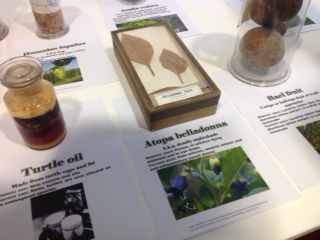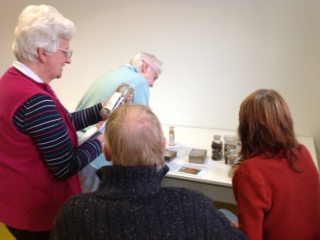Month: October 2014
Trick or Treat!
by Jemma.
It’s Halloween! A time for magic, spells and potions! We have many plants in the Materia Medica that were used for mystical purposes. So if you are a witch in need of ingredients for your flying ointment: we have belladonna, which you can mix with hemlock, wolfsbane and other such ingredients to make your broom fly high into the sky. We also stock Tonka beans, magic beans that are said to grant wishes! Or if you have been bitten by a werewolf and are in need of a cure: have no fear for we have Colocynth pulp, one of the cures for lycanthropy! We have everything you need and more to survive this night intact.
Happy Halloween everyone!





Russia study visit
 I am currently in Russia on a study visit with Janneke Geene from the People’s History Museum. The trip is funded by Arts Council England and organised by the lovely people at the British Council.
I am currently in Russia on a study visit with Janneke Geene from the People’s History Museum. The trip is funded by Arts Council England and organised by the lovely people at the British Council.
The idea of the trip is to put together a toolkit to help regional UK museum better cater for Russian tourists and to promote our museums over here. we have a packed schedule of visiting museums here in Moscow and and in St Petersburg and meeting
journalists, tour operators and Visit Britain colleagues.
After landing in Moscow our first visit was to the amazing State Darwin Museum.
We had a fantastic tour with the Director Anna Klukina.

 Here are a few things we learnt:
Here are a few things we learnt:
- most museums in Russia charge an entrance fee (about£5 in this museum)
- they generate a large income from hosting birthday parties
- they don’t really get many foreign tourists…
View original post 90 more words
Old wives tales?
Some of the Materia Medica jars have been dusted off and used for a creative writing session as part of the Manchester Science Festival 2014. Many lovely people turned up for the event and used the jars as inspiration to write some poetry. Here are some of the poems that were produced:
Cancer Defeated by Nick Duffy
Radioactive
Energy
Medical
Experiment
Defeated
You
The Old Ways: Alternatives by Diane Duffy
What is left of the old ways?
Old wives’ tales,
Old wives.
Shrivelled nature dried under glass,
Decayed matter on a shelf.
On the shelf
The woman and her cures become one
A metaphor for the past.
Alternatives?
Alternative – no alternative.
Wise woman translated into WITCH.
Which to choose?
Now we have a choice!
The Materia Medica by Jemma Houghton
Down the spiral staircase
Through that old wooden door
Find yourself in a magical place
Strange looking jars from ceiling to floor
Through that old wooden door
Big jars, little jars, flat and tall too
Strange looking jars from ceiling to floor
Look them up and see what they do
Big jars, little jars, flat and tall too
Find yourself in a magical place
Look them up and see what they do
Down the spiral staircase
Thank you to poet Tony Sheppard, for running an interesting session, and to all who turned up to the event.




Old wives tales?
Old Wives Tales?
Thurs 23 Oct, 2-4pm. Taking inspiration from the Museum’s fascinating material medical collection, explore our relationship to medicine through conversation and creative writing. Chat about family remedies and whether there’s any truth behind natural cures. Take part in simple poetry exercises to compose your own piece about your experiences and memories. With poet Tony Sheppard and Curator of Botany, Rachel Webster. Part of Manchester Science Festival, supported by Siemens.
Price: Book on 0161 275 2648 or museum@manchester.ac.uk, free, adults
Visiting Liverpool World Museum

This time last week we travelled over to Liverpool to catch up with colleagues who work in herbaria in the North West of the UK. It was lovely to have the opportunity to get together and discuss what we’re all doing (projects, aquisitions and the day to day) and it also meant that we got to have a good look round the Liverpool herbarium. With our storage looking like this:

………….Liverpool’s was a vision of order and function. Lindsey and I have got our eye on a few improvements to try out!



We also had a tour of the museum’s City Wildflower Meadow by Donna Young, Curator of Herbarium, . In prime postition right at the main entrance, the meadow is now in it’s second year and must have been a blaze of colour in midsummer. It had largely run to seed when we visited, but there were still a few flowers (such as yellow toadflax, the odd scabious flower and some dark mullein) making the most of the last days of summer. Donna explained that this year the yellow rattle (Rhinanthus minor) had really started to settle in and as it parasitises the more vigorous plants like grasses it will help to maintain the diversity of the meadow in future. We’ll have to come see it in all it’s glory next year!

NHM (part 1)…
Adam, the (Trainee) Natural Science Curator
Last week, myself and the other 2 Natural History curatorial trainees (Glenn & Lukas) spent a week on placement at the Natural History Museum, London. It was a great week, and I’d like to start out by saying a huge thank you to all the staff that took time out of their day to show us around and answer our questions.
It started on Monday, with the 3 of us being met by Clare Valentine, the Head of Collections for Zoology. After Clare took us for our security passes we went to Clares office to have a quick chat and a cup of tea. Clare gave us a brief introduction to some of her responsibilities and an overview of the staff structure of the NHM (around 100 curators itself I found was an impressive number!).
Clare then took us on a brief tour of some of the Zoology stores. The spirit…
View original post 483 more words








